Guest post by Contributing Editor and Chief Husband Chris.
I have always tried to be a good sport, a willing participant, and even an Eager Beaver when it comes to Rachel’s family’s Greek cuisine. And so far, I have grown to like everything, with the exception of Kalamata Olives. That’s what Meat Loaf was talking about when he said “But I won’t do that.”
Anyway, I have gotten so into the Greek cuisine that we seek out Greek restaurants anytime we travel.
One of the common appetizers at Greek restaurants is Saganaki – a fried cheese that usually gets flambéed at the table, a technique – which I have learned from such notable Greeks as John Krontiras, the owner of Nabeel’s Cafe & Market – is a purely theatrical American addition to Saganaki. Real Greecey Greeks just fry it.
Let me jump in here with a plug for the aforementioned Market, where John’s wife will gladly sell you all manner of imported cheeses and house made goodies – our favorites are the pimento cheese and the tabouli. All of the cheese harmed in the making of this blog came from this market.
This particular dish had never made it to our family table for ethnic dinnertime, so I really felt like this was an Eager Beaver’s chance to bring something legit (and theatrical) to the family palate.
A quick Google search will give you a plethora of options for making Saganaki – nearly the variety you get by asking different Greek chefs how to make the stuff.
So that leaves you with the option of trial and error.
The basic recipe is fry the cheese, pour a little alcohol over it, light it and watch it burn, and then squeeze lemon juice over it. All variations that fit within that framework are negotiable, such as which cheese? Lightly, heavily, or not breaded? Which liquor? Et Cetera.
My first attempt was last year. I bought Keflograveria cheese from Nabeel’s, then sliced it, rinsed it with water, lightly breaded it with seasoned flour, fried it for a few minutes on each side in olive oil, transferred it to a baking dish, poured a shot of brandy over it, torched it, and then put out the flame [too early] by squeezing lemon juice over it.
It was definitely edible, but the overwhelming taste of brandy was a lesson learned…Happy Easter Lunch everybody.
During Blogher last year, Rachel and I found a New York City Greek Restaurant and ordered Saganaki. And, as is my custom, I asked the waiter about it. He told me I should definitely do what they do and use Halloumi cheese flambéed in Ouzo, the traditional old man Greek liquor.
This variation excited Rachel quite a bit, because she had fond memories of Halloumi cheese from her teenage missions trip to Cyprus. My next experiment happened on Christmas Eve 2012. I bought Cypriot Halloumi (Nabeel’s Market again) and a bottle of Greek Ouzo (can’t tell you where I got this, but good luck.)
Let me pause here and say that I always imagined Greek old men sitting around and drinking something that would peel paint off a battleship, but that is incorrect. Ouzo is very fruity and deeply tasting of licorice.
Greektini, if you will.
Same recipe, except this time I used [too much] olive oil, but took care to let the ouzo burn out before I put the lemon juice on it.
It was much better than the first time,
just a bit too oily.
In my most recent attempt, I again resorted to the Halloumi. This time, my cheese allotment was a mere three days from it’s expiration date, a quality that I would like to believe added an even more authentic flavor.
I barely put in enough oil to cover the bottom of the frying pan, and it all turned out quite nicely.
The Ouzo again left no fruity overtones, probably since I let it burn out.
I am looking forward to many happy years of fried Greek cheese. And this one nasty bottle of licorice-flavored goodness should last for quite awhile.
So. In case you weren’t able to internalize that rambling recipe, here it is:
2 packages of Halloumi or Keflograveria Cheese
Olive Oil
Flour, mixed with salt, pepper, and greek seasoning (optional)
1 shot of Ouzo or Brandy
1 Lemon
A reliable source of fire.
1. Slice the cheese into 1/2 inch slices. Rinse slices in water.
2. Flip slices in flour mixture.
3. Heat Olive Oil in a pan (just enough to cover the bottom).
4. Fry cheese on medium-high for a couple of minutes on each side.
5. Place cheese into a separate dish, pour liquor over it, dim the lights and light it.
6. After the flames die out, squeeze lemon over cheese. Serve immediately.
Good luck and keep the fire extinguisher handy.

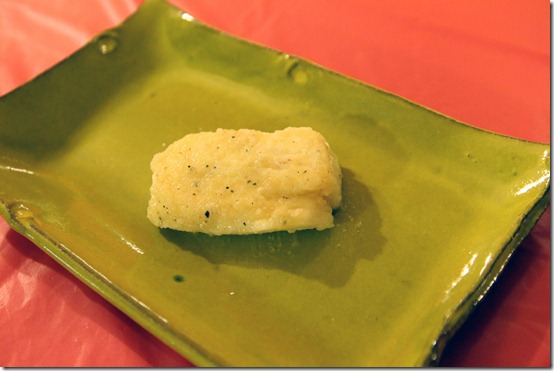
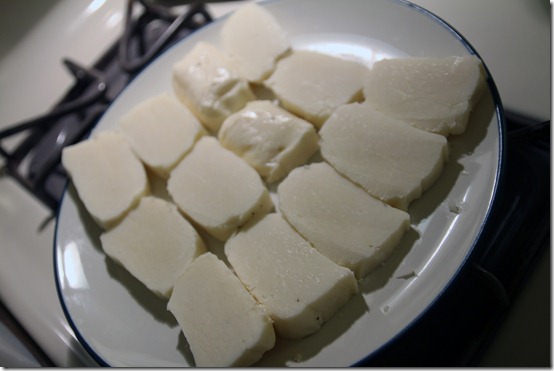
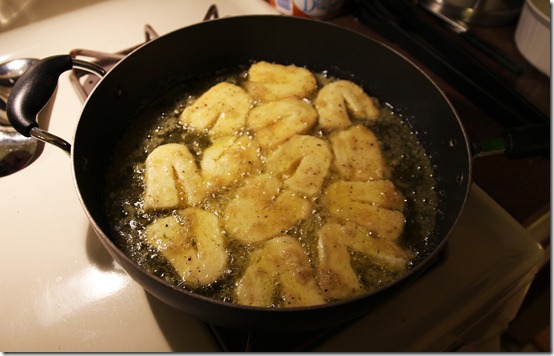
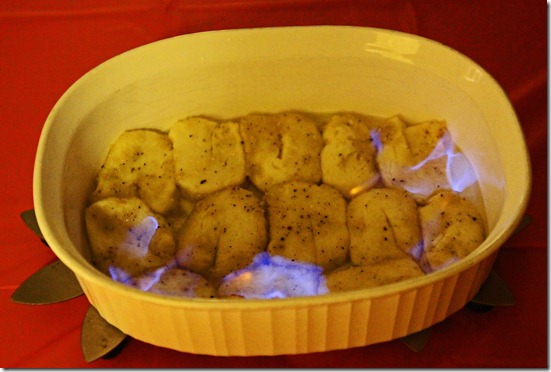
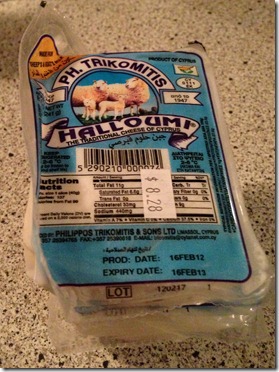
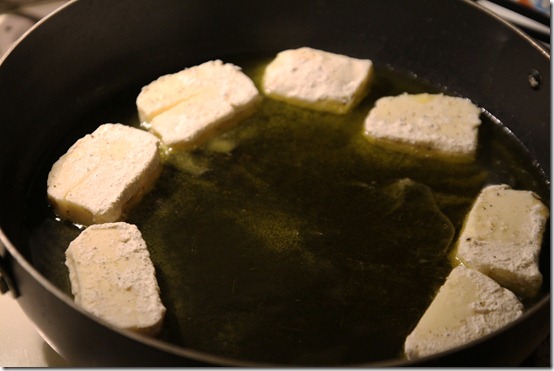
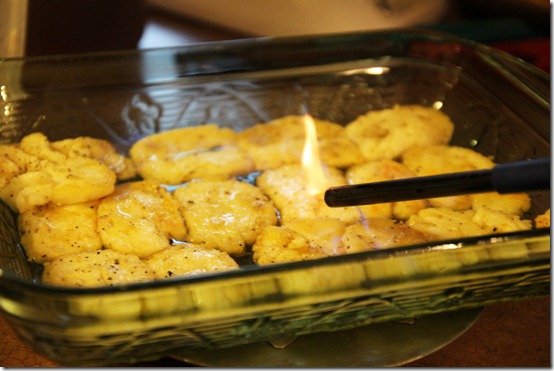
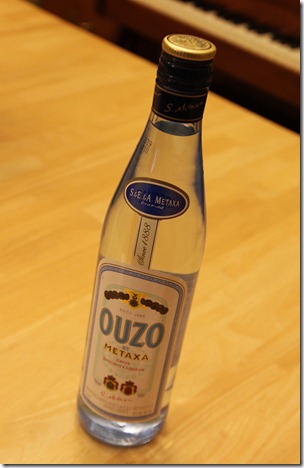
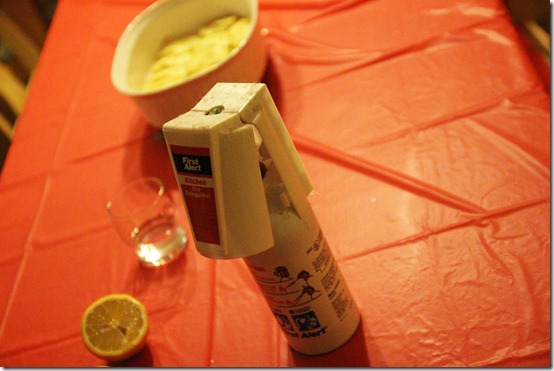
Interesting! We usually use Kefalotyri, as it’s the most commonly available saganaki cheese around here. For whatever reason it often comes in thick triangular wedges – I prefer to buy it in nice thin rectangular pieces so that they cook evenly, but usually end up having to cut it up into pieces. If you cut too thickly, it really doesn’t work the same way.
We also rinse in water, then cover in rice flour (I need a gluten free version!). Then we fry in a non-stick frying pan. We used to use oil but after a slight incident involving slightly scorched eyebrows and concern over our 9ft high ceiling we stopped – we find that some oil seeps out of the cheese as it heats. We tend to make enough saganaki for 12, so that one time it got quite oily. It was a pretty spectacular fireball though :)
We’ll have to try ouzo – I think we usually use cognac. Setting things on fire is about the only time we ever use alcohol though, so we’re not exactly connaisseurs :)
Interesting! And I’m glad to know there’s a gluten-free version available for those that need it.
My husband and I were at Disney this past October and the Food & Wine festival just so happened to be going on at Epcot. At the Greece kiosk, one of the food items they had was this amazing fried cheese with honey and pistachios on it. It was so good…I got one every day we were there and I was so sad when we got home and I couldn’t eat my “Greek cheese” everyday. So I am super excited to try this recipe!! Do you think that the honey + pistachios would be good on top of this one? Or was that just something they did for us Americans?
Thanks, Chris & Rachel for sharing more Greek goodness!!
That’s awesome! I’m glad you got to try it there. AND YES – Honey and pistachios sound amazing. I’m going to have to try that next time!
Yum! I love halloumi (and pretty much any kind of fried/melted/grilled/fondue etc cheese. Mmm… cheese…).
that sounds so yummy. some day i will have to try it. however, i’ve never been to a greek restaurant! i think i’m missing out. when you make it, is the cheese very crispy? i wonder if it would help to fry the cheese longer before flipping it? something i learned on some movie… haha
The cheese is crispy on the outside, and chewy on the inside – it doesn’t actually melt.
You had me at “fried cheese”. Yum.
This is all I want for supper next time I am up. YUM.
Mmmmmmmmmmmmmmmm. Please come make that at my house.
Great post, Chris! I’m surprised fried cheese isn’t a southern delicacy! 2 things we southerners love! I might get brave & try this in the far-off future ;-)
Hey there! A greecey greek here- as you would call me – actually reading you from Greece right now. I stumbled upon your blog via a random tutorial generator and sth kept me scooping through your posts.
So no, in Greece I’ve never heard of saganaki flambee – and I can’t tell you how hard I laughed with keflograveria instead of kefalograviera. A very solid effort for an american though – and the marks of a great husband who tries to cook you greek delicacies .
All in all, greetings from Greece to a really good blogger and her beautiful family
Thanks for saying hi! I love my Greek readers. I hope to make it back over there one day soon!